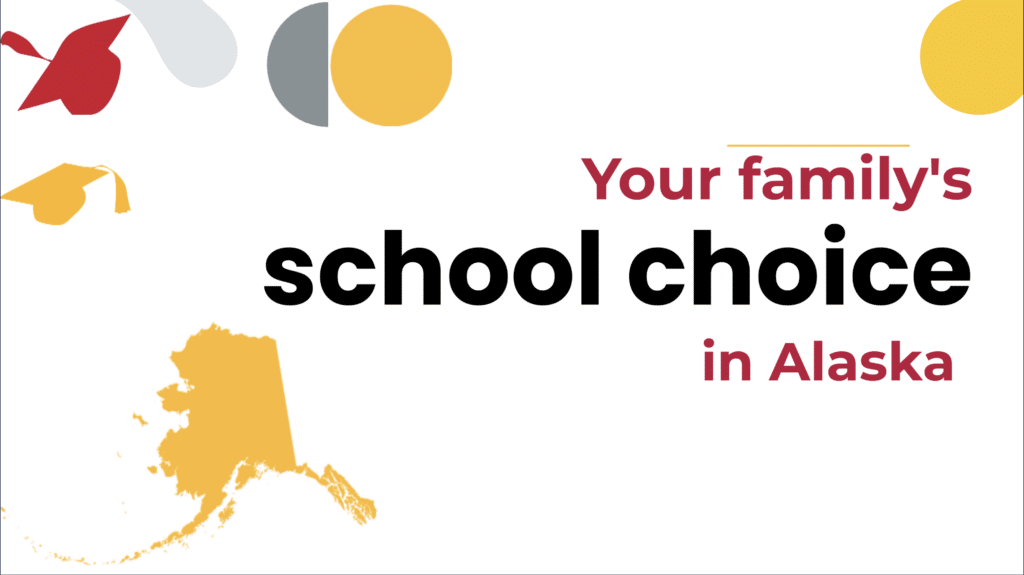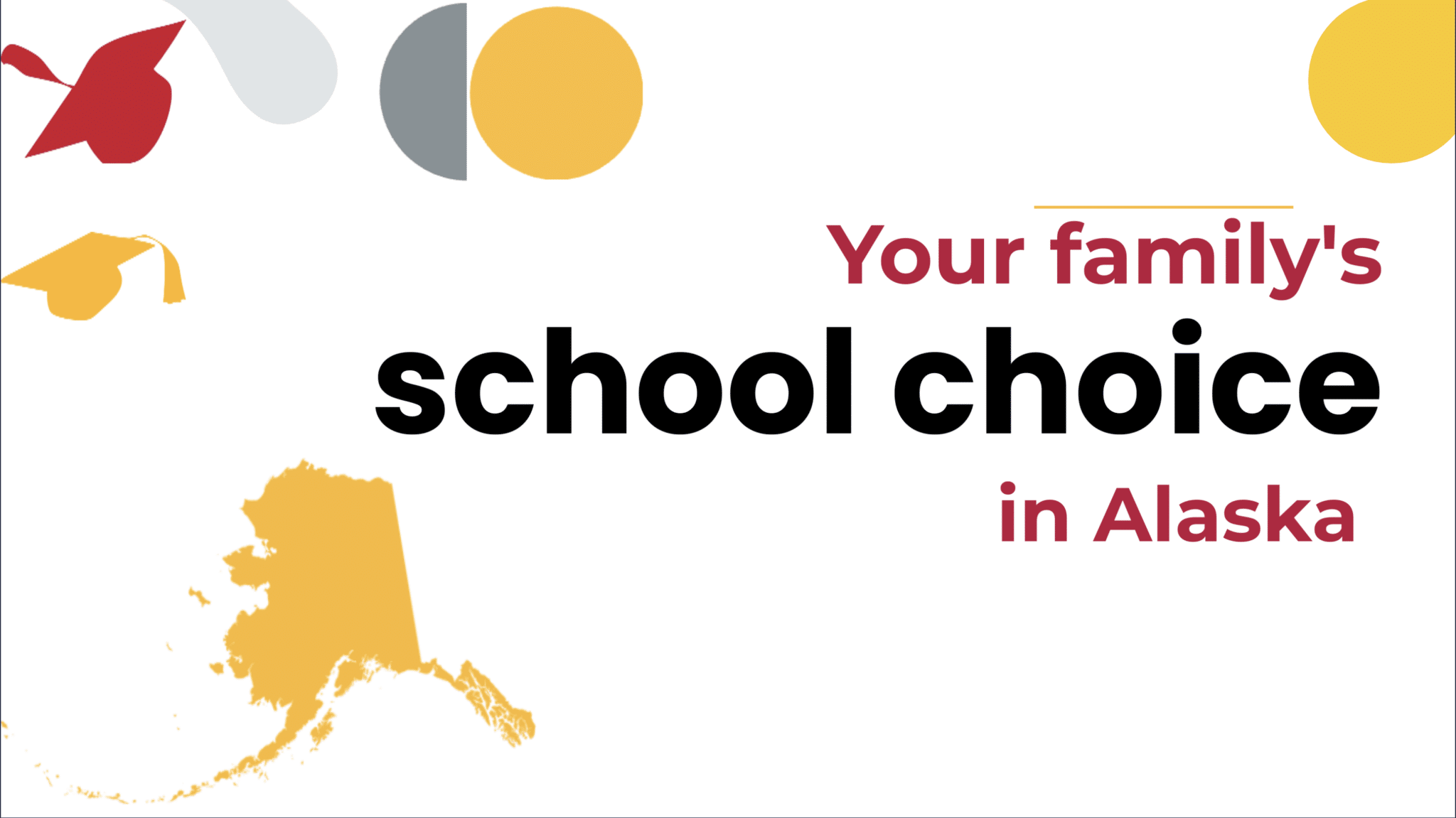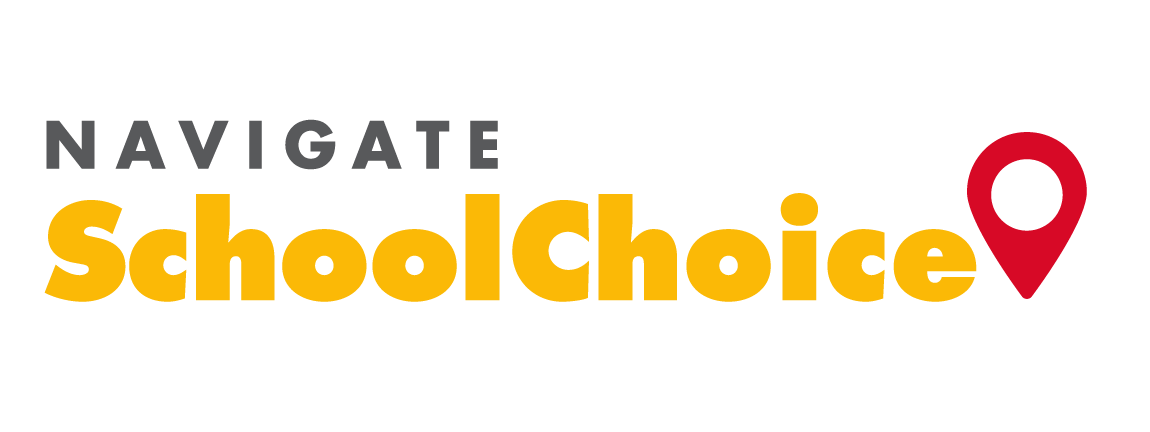Choosing a school? You’ve got options.
If you live in Alaska and are making a decision about K-12 education for your child, this post is for you. Where you send your child to school is one of the most impactful decisions you can make, but you’re not alone in it. Thousands of Alaska parents make school choices each year. And remember, each child is unique. So, the “best” school for your child may look different than the “best” school for your neighbor’s child.
A good starting point for choosing a school is knowing your options. This post will break down the main learning environments available in Alaska. In short, you can choose from traditional public schools, public charter schools, public magnet schools, private schools, online learning, homeschooling, and microschooling and mix-and-match learning.
Looking for special education options? You can learn what special education services are available in Alaska at the Ultimate Guide to Special Education.

- Traditional Public Schools
- Public Charter Schools
- Public Magnet Schools
- Private Schools
- Online Schools
- Homeschool
- Microschooling
Alaska Traditional Public Schools
By far, most families in Alaska (68.8%) and around the country choose traditional public school. Traditional public schools are free to attend, open to all students, operated by school districts, and funded by federal, state, and local government.
Did you know that Alaska spends an average of $19,540 per pupil in public school? You can search your school’s spending and that of nearby schools at Project Nickel.
Alaska has limited open enrollment laws for public schools. What this means is that parents of students who are assigned to a particular neighborhood school may in some cases be able to transfer their children to another school in their district. For example, the Fairbanks North Star Borough School District has an online application portal where families can apply to a school outside their zoned “attendance area.” In other cases, children may be required to attend the school assigned to them by their district.
Open enrollment is an important way that parents have access to a broader variety of public schools. Find out more about public schools in your state at the Alaska Department of Education & Early Development and contact your school district to learn about your open enrollment options. You can also learn more about Alaska’s open enrollment options in this 50-state report.
Alaska Charter Schools
Depending on where you live in Alaska, public charter schools may be another public school option available to you. Like traditional public schools, charter schools are public, free, and usually have no requirements for entry. What distinguishes charter schools is that they have extra freedom to innovate with learning methods and are accountable to authorizers for results.
Alaska passed charter school legislation in 1995 and currently has more than 30 charter schools that serve more than 7,000 (5.8%) students. Each school has a charter which explains the school’s purpose and what specific community need it serves. For example, one of Alaska’s newest charter schools is Knik Cultural School, which offers Alaska Native culture and values-based learning opportunities, such as fishing, moose hunting, and berry picking! If there are more families seeking admittance to a charter school than there are seats, a good old-fashioned lottery system is typically used to determine admittance.
Free transportation is available to some students who attend charter schools in Alaska and live within the district where the charter school is located. All students with special needs who have an Individualized Education Program (IEP) are eligible to receive transportation assistance.
Find frequently asked questions about Alaska charter schools at Alaska’s Department of Education & Early Development.
Alaska Magnet Schools
A third free, public school option is found in Alaska’s magnet schools. Magnet schools allow kids to narrow in on a specific learning track, such as engineering or the performing arts. Magnet schools teach all subjects through the lenses of their specific track. In Alaska, 12.2% of all K-12 students attend a public magnet school.
Alaska has a handful of magnet schools scattered throughout the state. For example, Barnette Magnet School, located in the Fairbanks North Star Borough District, describes its offering this way: “Barnette’s magnet or ‘draw’ is a combination of: small exploration classes, a community-based Friday in Fairbanks Program, and quarterly all-school Exhibit Nights. These are the elements of the school that set it apart from other schools and make the Magnet School experience a rewarding one for both students and parents.”
If you’d like to learn more, you may want to check out U.S. News & World Report’s ranking of magnet high schools in your state.
Alaska Private Schools
Families in Alaska can also consider private schools, nonpublic schools that charge tuition. Private schools may offer a unique curriculum, smaller class sizes, or a faith-based tradition. Overall, there are more than 50 private schools across the state of Alaska serving 3.1% of all K-12 students. These private schools come in all shapes and forms, from religious schools to schools designed for children with special needs. The average tuition for private schools in your state is $7,154 for elementary schools and $6,881 for high schools.
Unfortunately, there are no state-run scholarship options in Alaska at present, but private scholarships may be available. Additionally, Alaska has a funding assistance program that can make some private school courses more affordable for families. Essentially, the state sets aside funds in the form of an annual allotment for students enrolled in a state-funded correspondence program. Families can then use their student allotment to request reimbursements for approved educational expenses. Currently, this may include courses at private schools (though not full-time tuition).
Learn more at the Alaska Department of Education & Early Development, Catholic Education – Archdiocese of Anchorage, and Private School Review: Alaska.
Alaska Online Learning
Whether your child wants to accelerate learning or needs a quieter environment in which to focus, you may be interested in giving virtual school a try. Of course, virtual school is different and may feel like “drinking from a fire hose” at first, but for many families it becomes the perfect fit. Alaska doesn’t offer any statewide online schools or multi-district online schools, but families can consider national online learning programs, like Virtual Learning Academy Charter School, The Keystone School, and Laurel Springs School, for a fee.
On the district level, middle- and high-school students in Ketchikan Gateway Borough School District can enroll in online courses through the Alaska Digital Academy. Plus, the ASD Virtual Program offers a free, fully online home learning program that Anchorage families can choose through their neighborhood or choice school. The virtual learning program is staffed by Anchorage School District teachers and allows families to maintain a connection to their local school. The Fairbanks North Star Borough School District also offers online options for grades 6-12, and you can always ask your district about whether an online program is available to you.
In 2022, the Alaska legislature approved a new virtual education consortium. Once established, this will provide a library of virtual classes available to Alaska students. Additionally, Alaska has many correspondence school offerings, some of which are free, that families can choose from.
To read more about online learning in Alaska, check out the Digital Learning Collaborative’s state profile.
Alaska Homeschooling
Alaska parents can also choose homeschooling, which sets a high bar for flexibility and customization for education. Homeschooling is the process of parents educating students at home and is an option in all 50 states.
In Alaska, 10.3% of all K-12 students are homeschooled. The state only requires notice of your intent to homeschool if you are homeschooling as a religious private school. If so, you will need to provide notice by the first day of school. Of course, it is recommended that you formally withdraw from your current school so that your student is not marked truant. If you decide to switch back to public school, a portfolio of work or assessments will be used for placement.
You are not required to teach specific subjects or use specific standardized tests if you choose to homeschool in Alaska. If you homeschool, your child might still be eligible to participate in sports or activities at local public schools – reach out to your district to learn more.
Alaska stands out among the states for its flexible funding assistance program available to many homeschoolers! Essentially, the state sets aside funds in the form of an annual allotment for students (including homeschoolers) enrolled in one of more than 30 state-funded correspondence programs. According to Alaska’s Department of Education & Early Development, “This allotment can pay for items such as a student’s books, classes, school supplies, technology support, tutoring, music or activity lessons, and other items related to the student’s education.”
This allotment helps make homeschooling more affordable for some families. Note that the allotment amount may vary by correspondence program and may not be used to purchase religious curriculum. Homeschool in Alaska offers families clear information about allotment funds, as well as tips for selecting the best correspondence program or homeschool program for your family. As of 2024, this program is currently under ongoing legal discussion. Check back for more updates.
You may also wish to check out the Home School Legal Defense Association – Alaska or the Alaska Private and Home Educators Association.
Alaska Microschools and Mix-and-Match Learning
Today, many Alaska families are mixing and matching school options to come up with new ways to personalize education. Microschools are one of these ways. A microschool refers to students gathering together in a small group – with adult supervision – to learn, explore, and socialize. Microschools can take a variety of shapes and legal forms, from homeschoolers coming together at an enrichment center to a private school committed to small classrooms. What microschools share in common is a commitment to small-group learning, close-knit relationships, and emphasizing children as individual learners.
Here is one example of a microschool started by homeschoolers in Alaska: The Green Room in East Anchorage is a learning community offering in-person classes for homeschoolers, from chemistry to wholeness and health classes.
Remember, microschooling is more a mentality than a specific legal distinction in most cases. Often, a family participates in a microschool while legally homeschooling, or being enrolled in a private or online school.
[nscw_school_finder]
Microschooling and Mix-and-Match Learning
How can it empower parents and help kids achieve their dreams?
7 Step Guide
Tips to help you find a school where your daughter or son will learn, succeed, and be happy.
Education Resources for
Alaska Parents
For additional information about school choices in
Alaska, visit these resources:
Every state is different when it comes to school choice options.
Sign up below to get a detailed comparison:
"*" indicates required fields


